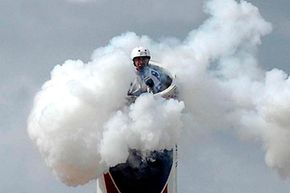It's a bird! It's a plane! It's…Uncle Hugo?
Human beings have always dreamed of flying through the clear blue sky -- and, in some ways, they've succeeded. Parachutes, jet packs, and planes, among many other technological marvels, let us find a way to blaze through the heavens. But human cannonballs take a unique path to the wild blue yonder -- an extremely dangerous one.
Advertisement
Human cannonballs are pretty much exactly what they sound like: These daredevil performers pack themselves into the tight confines of huge cannons, which shoot them high into the air. This performance has a long history with roots in old-time circuses, but as you'll see, no one has mastered the art of becoming a human bullet yet.
It's certainly not for a lack of trying. People have been tinkering with the cannonball idea since the late 19th century. On June 13, 1871, an Englishman named George Farini patented a so-called "projector," which was simply a spring-loaded platform he used to flip people into the air at public venues throughout the country.
In 1873, a man masquerading as a woman, "Lulu," was the first person in America to go airborne via Farini's contraption. Lulu might've gone as high as 25 or 30 feet (7.6 or 9 meters) and, at the apex of her flight, she grabbed onto a trapeze or rope.
It wasn't until 1880, however, that a person -- a 14-year-old girl named Rosa Maria Richter, stage-named Zazel -- finally clambered inside an actual cannon, courtesy of famed circus entrepreneur P.T. Barnum. The cannon used springs to propel her into the air, as fireworks simultaneously exploded for effect. Zazel was also one of the first casualties of this circus thrill act. At another performance, she broke her back, ending her career as Barnum's first human cannonball.
Around the same time, the Yankee Robinson Circus was working on its own cannonball act. The company shot a man named George Loyal out of a cannon toward a woman on a trapeze, who would catch him in midflight. And that was just for starters.
If all of this sounds like a perilous way to make a living, well, you're right. Keep reading to find out how human cannonballs get their wings -- and what happens when landings go horribly awry.
Advertisement




